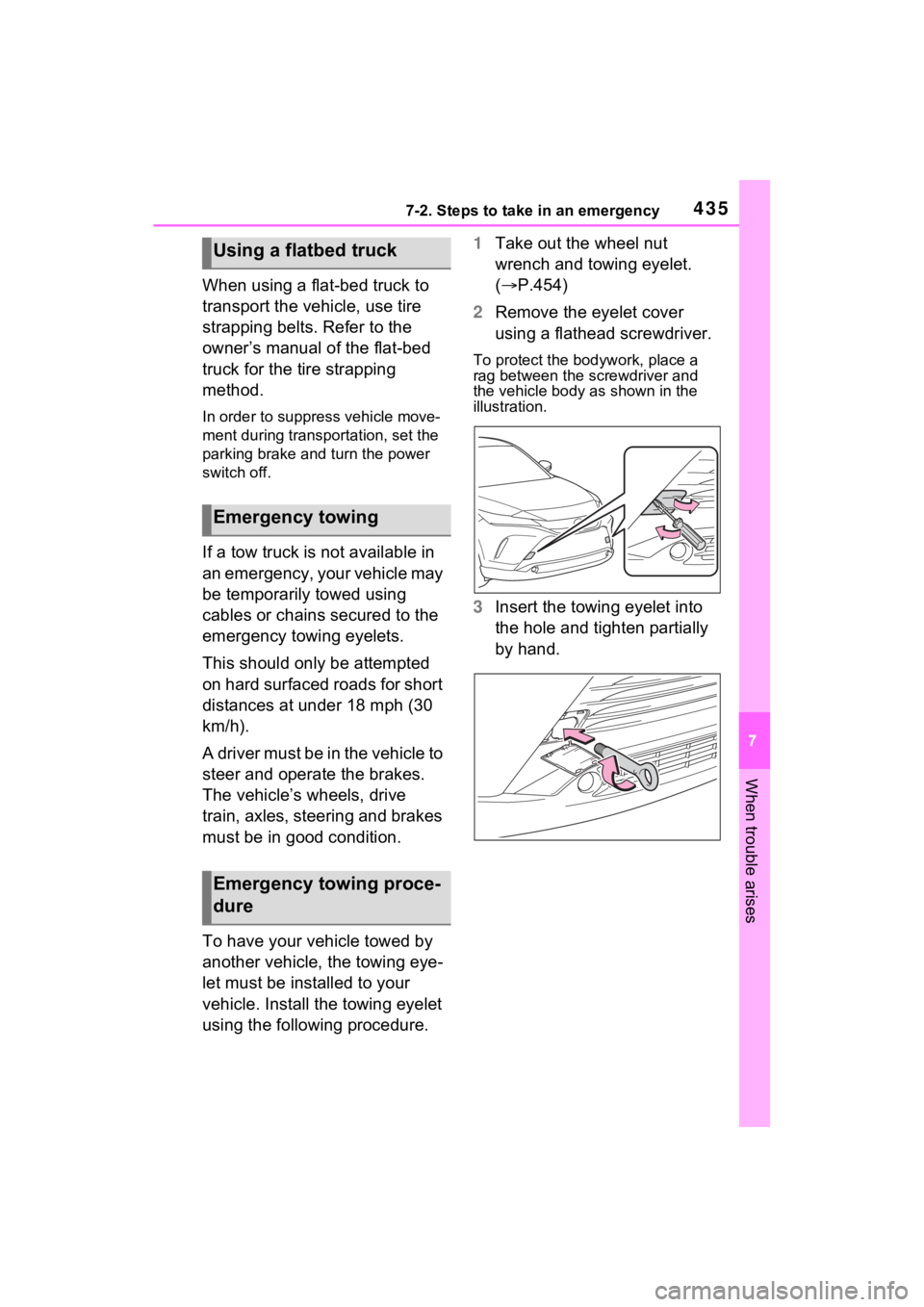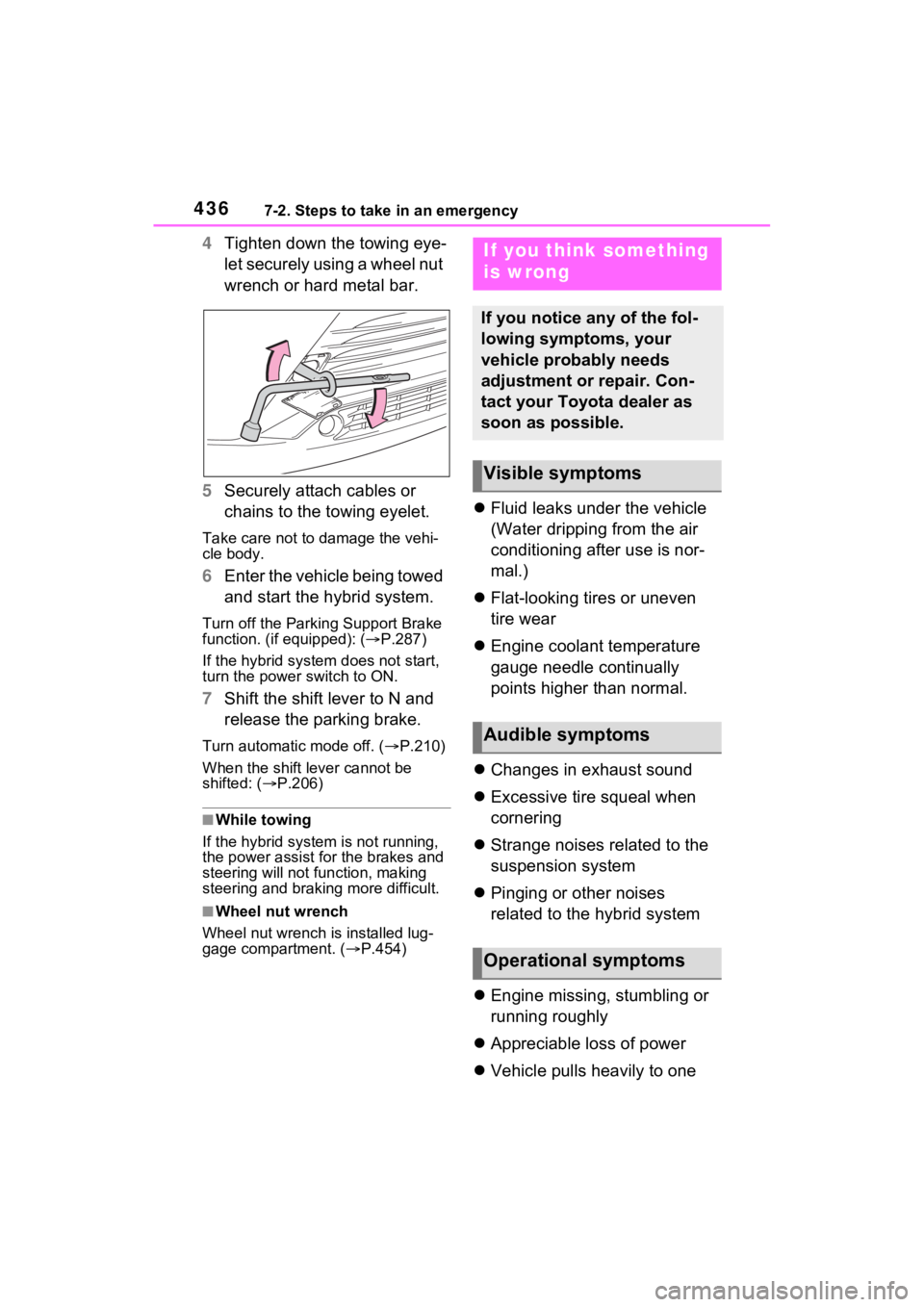Page 435 of 548

4357-2. Steps to take in an emergency
7
When trouble arises
When using a flat-bed truck to
transport the vehicle, use tire
strapping belts. Refer to the
owner’s manual of the flat-bed
truck for the tire strapping
method.
In order to suppress vehicle move-
ment during transportation, set the
parking brake and turn the power
switch off.
If a tow truck is not available in
an emergency, your vehicle may
be temporarily towed using
cables or chains secured to the
emergency towing eyelets.
This should only be attempted
on hard surfaced roads for short
distances at under 18 mph (30
km/h).
A driver must be in the vehicle to
steer and operate the brakes.
The vehicle’s wheels, drive
train, axles, steering and brakes
must be in good condition.
To have your vehicle towed by
another vehicle, the towing eye-
let must be installed to your
vehicle. Install the towing eyelet
using the following procedure. 1
Take out the wheel nut
wrench and towing eyelet.
( P.454)
2 Remove the eyelet cover
using a flathead screwdriver.
To protect the bod ywork, place a
rag between the screwdriver and
the vehicle body as shown in the
illustration.
3 Insert the towing eyelet into
the hole and tighten partially
by hand.
Using a flatbed truck
Emergency towing
Emergency towing proce-
dure
Page 436 of 548

4367-2. Steps to take in an emergency
4Tighten down the towing eye-
let securely using a wheel nut
wrench or hard metal bar.
5 Securely attach cables or
chains to the towing eyelet.
Take care not to damage the vehi-
cle body.
6Enter the vehicle being towed
and start the hybrid system.
Turn off the Parkin g Support Brake
function. (if equipped): ( P.287)
If the hybrid system does not start,
turn the power switch to ON.
7 Shift the shift lever to N and
release the parking brake.
Turn automatic mode off. ( P.210)
When the shift le ver cannot be
shifted: ( P.206)
■While towing
If the hybrid system is not running,
the power assist for the brakes and
steering will not function, making
steering and braking more difficult.
■Wheel nut wrench
Wheel nut wrench is installed lug-
gage compartment. ( P.454)
Fluid leaks under the vehicle
(Water dripping from the air
conditioning after use is nor-
mal.)
Flat-looking tires or uneven
tire wear
Engine coolant temperature
gauge needle continually
points higher than normal.
Changes in exhaust sound
Excessive tire squeal when
cornering
Strange noises related to the
suspension system
Pinging or other noises
related to the hybrid system
Engine missing, stumbling or
running roughly
Appreciable loss of power
Vehicle pulls heavily to one
If you think something
is wrong
If you notice any of the fol-
lowing symptoms, your
vehicle probably needs
adjustment or repair. Con-
tact your Toyota dealer as
soon as possible.
Visible symptoms
Audible symptoms
Operational symptoms
Page 454 of 548
4547-2. Steps to take in an emergency
Towing eyelet
Jack handle
Wheel nut wrench
Spare tire
Jack
Location of the spare tire, jack and tools
A
B
C
D
E
�:�$�5�1�,�1�*
■Using the tire jack
Observe the following precau-
tions.
Improper use of the tire jack may
cause the vehicle to suddenly fall
off the jack, leading to death or
serious injury.
●Do not use the tire jack for any
purpose other than replacing
tires or installing and removing
tire chains.
●Only use the tire jack that
comes with this vehicle for
replacing a flat tire.
Do not use it on other vehicles,
and do not use other tire jacks
for replacing tires on this vehi-
cle.
●Put the jack properly in its jack
point.
Page 474 of 548

4747-2. Steps to take in an emergency
1Stop the hybrid system. Set
the parking brake and shift
the shift lever to P.
2 Remove the mud, snow or
sand from around the front
wheels.
3 Place wood, stones or some
other material under the front
wheels to help provide trac-
tion.
4 Restart the hybrid system
5 Shift the shift lever to D or R
and release the parking
brake. Then, while exercising
caution, depress the acceler-
ator pedal.
■When it is difficult to free the
vehicle
Press to turn off TRAC.
( P.297)
If the vehicle becomes
stuck
Carry out the following pro-
cedures if the tires spin or
the vehicle becomes stuck
in mud, dirt or snow:
Recovering procedure
WARNING
■When attempting to free a
stuck vehicle
If you choose to push the vehicle
back and forth to free it, make
sure the surrounding area is clear
to avoid striking other vehicles,
objects or people. The vehicle
may also lunge forward or lunge
back suddenly as it becomes free.
Use extreme caution.
■When shifting the shift lever
Be careful not to shift the shift
lever with the accelerator pedal
depressed.
This may lead to unexpected
rapid acceleration of the vehicle
that may cause an accident
resulting in dea th or serious
injury.
NOTICE
■To avoid damaging the trans-
mission and other compo-
nents
●Avoid spinning the wheels and
depressing the accelerator
pedal more than necessary.
●If the vehicle remains stuck
even after these procedures are
performed, the vehicle may
require towing to be freed.
Page 540 of 548

540Alphabetical Index
Seat ventilator switches ....... 331
Vehicle-to-vehicle distance switch ................................. 257
VSC OFF switch................... 297
Window lock switch .............. 181
Windshield defogger switch 313, 321
Windshield wiper de-icer switch ................................... 317, 327
Windshield wipers and washer switch ................................. 222
Wireless charger .................. 351
T
Tail lights Light switch .......................... 215
Replacing light bulbs ............ 428
Theft deterrent system Alarm ...................................... 80
Immobilizer system ................ 79
Tire inflati on pressure
Maintenance data................. 482
Tire inflation pressure display function............................... 399
Warning light ........................ 444
Tire information ...................... 488 Glossary ............................... 492
Size ...................................... 490
Tire identification number ..... 489
Tire section names ............... 490
Tire pressure warning system Function ............................... 399
Initializing ............................. 403
Installing tire pressure warning valves and transmitters ...... 402
Registering ID codes ............ 406
Warning light ........................ 444
Tires ......................................... 397 Chains .................................. 306
Checking .............................. 397
Glossary ............................... 492
If you have a flat tire ............. 453 Inflation pressure
..................409
Information ......... ..................488
Replacing .............................453
Rotating tires ........................399
Size ......................................482
Snow tires.............................304
Spare tire ..............................453
Tire identification number .....489
Tire inflation pressure display function ...............................399
Tire pressure warning system ...........................................399
Uniform Tire Qua lity Grading 491
Warning light ........................444
Tools ................................341, 454
Top tether strap ........................61
Total load capacity .........191, 194
Towing Dinghy towing .......................196
Emergency towing ................435
Towing eyelet ...............435, 454
Trailer towing ........................195
Toyota multi-operation touch 344
Toyota Safety Sense 2.0 ........230 Automatic High Be am ...........218
Dynamic radar cruise control with full-speed range ..........257
LTA (Lane Traci ng Assist) ....244
PCS (Pre-Collisio n System) .236
RSA (Road Sign Assist) .......254
TRAC (Traction Control) ........297
Traction battery (Hybrid battery) .................................................74Hybrid battery (tr action battery)
air intake and discharge vents .............................................77
Location ..................................74
Specification .........................478
Warning messages .................78
Traction Control (TRAC) ........297
Traction motor (electric motor)70
Trailer towing ..........................195